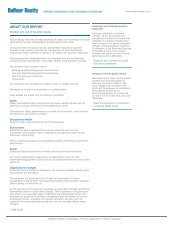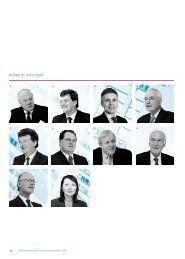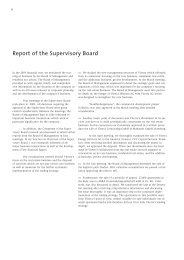E_mg_GB_03_vorne-29_3_04
E_mg_GB_03_vorne-29_3_04
E_mg_GB_03_vorne-29_3_04
Create successful ePaper yourself
Turn your PDF publications into a flip-book with our unique Google optimized e-Paper software.
66<br />
PERFORMANCE OF THE SUBGROUPS<br />
The performance of the subgroups varied in 20<strong>03</strong>. While the industrial plant engineering companies<br />
incurred heavy losses, the performance of GEA and Dynamit Nobel was relatively robust.<br />
Overall, the subgroups’ performance was hit by the continued ailing state of the economy and<br />
the adverse currency effects of the strong euro (especially against the U.S. dollar).<br />
Robust performance by GEA despite the impact of the economy and exchange rates<br />
GEA recorded lower new orders and sales in 20<strong>03</strong>. The main reason for this was the movements in<br />
the euro exchange rate against the currencies of major export markets. This was particularly true of<br />
the U.S. dollar and dollar-bloc currencies. Outside the United States, GEA’s sales grew by approximately<br />
five percent.<br />
At the beginning of the year under review, the structural organization of the GEA Group was streamlined<br />
further and the liquid-processing business was split up. Since then, the components business<br />
has been managed by the Process-Engineering Components division, and liquid engineering has been<br />
run by the Process Engineering division.<br />
The new Process Engineering Components division consists of the former Thermal Technology<br />
division, the components business of the former Liquid Processing division, and the homogenizer<br />
business. As expected, levels of new orders and sales declined slightly on a comparable basis, as<br />
the secondary energy market – which had been extraordinarily strong in previous years – weakened.<br />
By contrast, business in plate heat exchangers and homogenizers grew encouragingly.<br />
The Energy Technology business, particularly in the field of power plant cooling, continued to contract<br />
as expected. This was mainly due to the weakness of the U.S. market. Following the process<br />
of consolidation among competitors, the pressure on prices – even in growth markets – intensified<br />
significantly. The Energy Technology division achieved a few notable successes in southern Europe.<br />
The process cooler business grew despite the weak U.S. market. This was due, among other things,<br />
to the high levels of capital spending on natural gas, which is becoming increasingly important in<br />
the global mix of primary fossil fuels. The Energy Technology division managed to achieve strong<br />
double-digit growth in its services business.<br />
The Air Treatment division, which only operates in Europe, had to defend its market position in a<br />
chronically difficult market environment. Lack of activity in commercial building construction caused<br />
volumes to contract in Austria and, especially, Germany. By contrast, the Air Treatment business<br />
achieved growth in France and Belgium. The central and east European marketing companies offered<br />
a mixed picture. While business in Hungary and Poland contracted slightly, there were positive<br />
signs in Croatia, Lithuania, Slovakia, Slovenia, the Czech Republic, and Ukraine. The announced<br />
restructuring of production capacities was completed by the end of the year.









